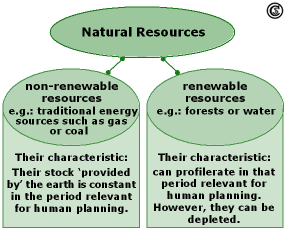Natural Resources
|
Natural resources are materials created in nature that are used and usable by humans. They include natural substances (e.g., soil, water) and energy supplies (e.g., coal, gas) that serve to satisfy human needs and wants (Barsch and Bürger 1996; Minc 1976).
Materials occurring in the environment thus are nothing more than ‘neutral matter’ until people recognise their presence, attach great importance to them, and develop means to capitalise on them. Then the natural materials fulfil a function (Barsch and Bürger 1996; Mitchell 2002). Natural resources are a component of the environmental setting. The environmental setting embraces the totality of materials, features and processes of landscapes. These environmental settings give the regions of the world their own, quite specific and distinctive settings with different options concerning the transmutations of materials and energy. The materials, features and processes which are usable constitute the potential of the landscape. By utilising parts of this potential, humans give them a new function, a new purpose: they make them into a source of subsistence – into a natural resource (Barsch and Bürger 1996). As Zimmermann phrased this process: „Resources are not, they become“ (Zimmermann 1951). Since this concept of natural resources was criticised as too anthropocentric, today many interpret resources much more broadly than in this functional or utilitarian sense. “In that context, resources are the abiotic, biotic and cultural attributes on, in or above the Earth” (Mitchell 2002, 6). Natural resources can be classified in various ways. A commonly used one is the classification of natural resources according to their exhaustibility and regenerative power. Non-renewable resources are differentiated from renewable resources (Barsch and Bürger 1996) (see figure).
|
Figure Classification of natural resources; after data from Enders and Querner 1993.
|
